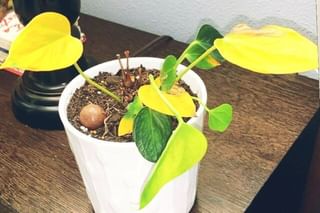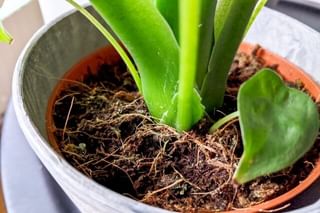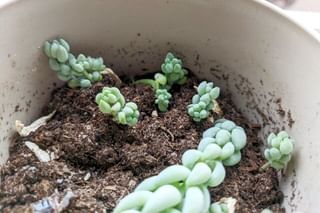How to rescue a plant from overwatering
Overwatering is the most common cause of death for house plants. But overwatering your plant doesn't have to mean it's a lost cause. There are several ways to help your plant recover from overwatering. In this guide, we'll go over what you can do when you've overwatered your plant.
 Overwatering is the most common cause of death for house plants. It's quite easy to think of watering your plants as giving them love because watering your plants helps them grow. However, not all plants like to be watered frequently.
Overwatering is the most common cause of death for house plants. It's quite easy to think of watering your plants as giving them love because watering your plants helps them grow. However, not all plants like to be watered frequently.
Cacti, succulents, sansevierias, and several other plants actually thrive when you forget to water them for longer periods of time. When you water these plants too much they will develop root rot and die. But is your plant really doomed when you overwater it? Can you rescue plants that have been overwatered too often and save them from death? Yes, luckily often you can and there are several solutions depending on how your plant is doing.
In this guide, we're going to look at a few solutions you can try when you're rescuing your plant from death when it has been overwatered too often. These solutions are these:
- Let the soil dry out completely
- Repot your plant to new soil
- Repot your plant to Leca
- Propagate your plant
As you might be looking at this post because your plant is dying from being overwatered, let's get into the content quickly.
Let the soil dry out completely
When you've overwatered your plant once or twice and your plant is showing a few symptoms, there are a lot of things you can do to help it. The simplest solution, in this case, is to stop watering your plant and let the soil dry out completely.
If your plant is not dying yet, but it's showing a few symptoms, changing your watering schedule is often enough to bring your plant back to health. By letting the soil dry out, you're giving the plant the time and space to recover. Overwatering your plants often has a side effect that oxygen can't reach your plant's roots anymore. By letting the soil dry out, oxygen will once again be able to reach the roots. This is often enough to help your plant recover and you can water it again.
Repot your plant in new soil
Sometimes letting the soil dry out takes too long and your plant is showing serious overwatering symptoms. If you let the soil dry out, it could take days and your plant might not be able to survive days in the soil. In this case, you can repot your plant in dry soil.
When you choose to repot your plant in dry soil, it's important to get right of wet soil that's around the roots of your plant and check the roots for root rot. If there are any roots that are dead, cut those away until you only have healthy roots left. These healthy roots will be able to provide your plant with nutrients, while the dead roots could cause root rot and attract insects.
When you've repotted your plant into new soil, be sure to keep the soil dry for 2 days and then water it a little. It's best if you use a pot with a drainage hole, to get rid of excess water. After you've done this, check up on your plant every few days to see if it's doing okay. If it's not doing any better after a week, you might have to check the roots for root rot again and get rid of the dead roots.
Repot your plant in Leca

Leca is a growing medium that helps you to properly water your plants. If you're struggling to properly water your plants in soil, Leca might be the perfect solution for you. Soil is an organic medium, which means it provides your plant with nutrients, but there is also a chance fungi could grow in it. Leca is not an organic medium, in fact, it doesn't provide your plants with any nutrients at all. Leca is designed to regulate water in the pot and only give your plants the water it really needs, nothing more, nothing less. As this is the sole purpose of Leca, it might be a great solution if your someone that's a little heavy-handed on watering your plants. The Leca helps you to avoid overwatering your plant. You can read more about the Leca at What is Leca and why is it useful for plants? and The pros and cons of using Leca to grow your plants.
Propagate your plant
If you've overwatered your plant to such an extend that not only the roots are heavily damaged, but also several leaves have died, there is only one thing left you can do to save your plant from dying: propagation. It technically doesn't save your plant, but you're getting a second chance at taking care of your plant, by growing new plants from the dying plant. This is often very easy with succulents, as you can propagate them by planting their leaves in soil, but propagation is possible for almost every plant, even if it's heavily damaged due to overwatering.
Most sansevierias can be propagated by cutting their leaves, letting them dry for two days, and then planting the leaves. This will grow new plants in a few months. If you have another plant you need help with, you can also look at our other guides about propagation.
Conclusion
When you overwater your plant, there are several ways to rescue it. Overwatering doesn't always have to mean that your plant dies. You can let the soil dry, repot your plant in soil or leca, or propagate your plant to not have to give up on your plant and let it die.
Of course, preventing overwatering your plant is always better than having to rescue it afterwards, so read How to avoid overwatering your plants to get some tips & tricks for next time.
Thank you for reading this post! I hope it helps you to keep your plants healthy and beautiful! If you're looking for more guides on specific plants, you can always request a plant guide to get a guide for the plant you have trouble with.
Test your plant care knowledge
Quiz completed!
Want to learn more? Sign up for my newsletter to receive free tips in your inbox!
Sign up now!












